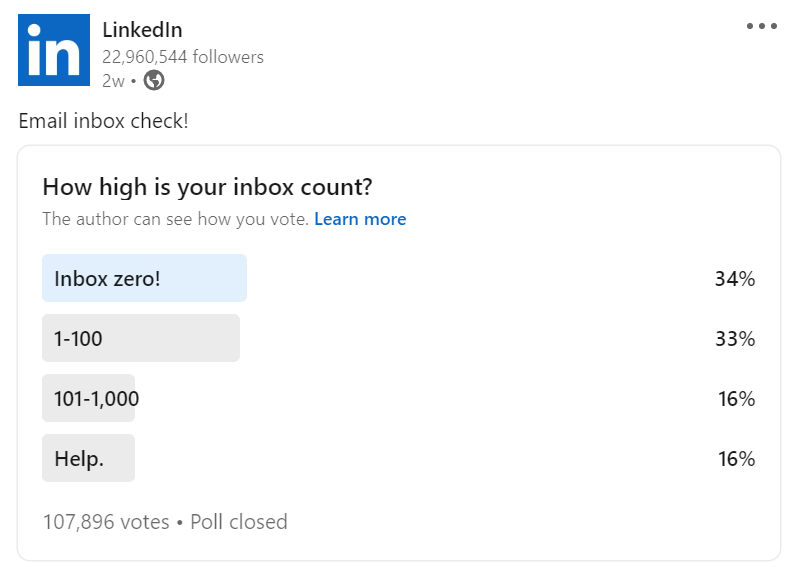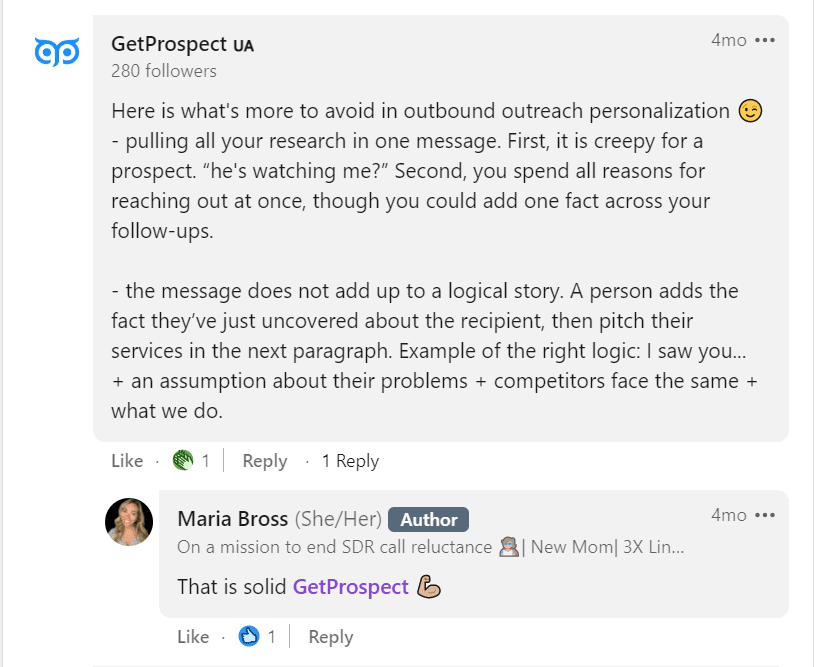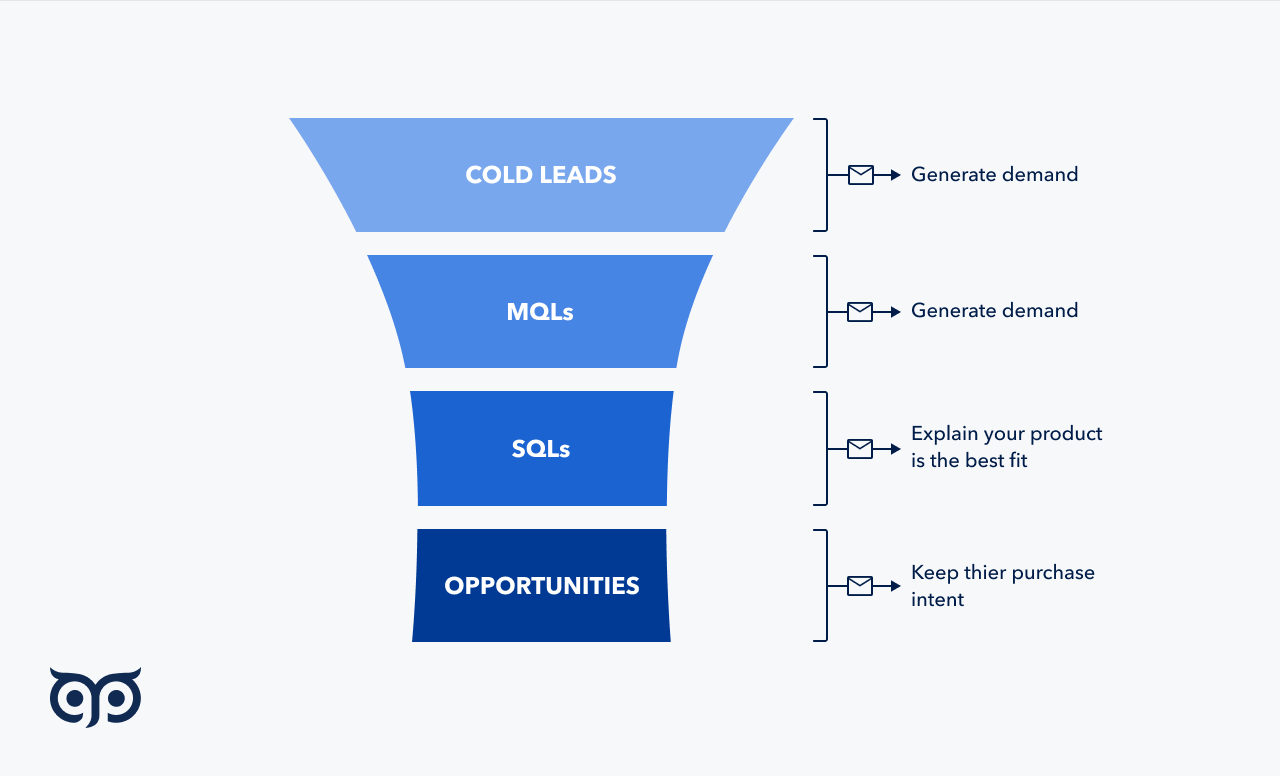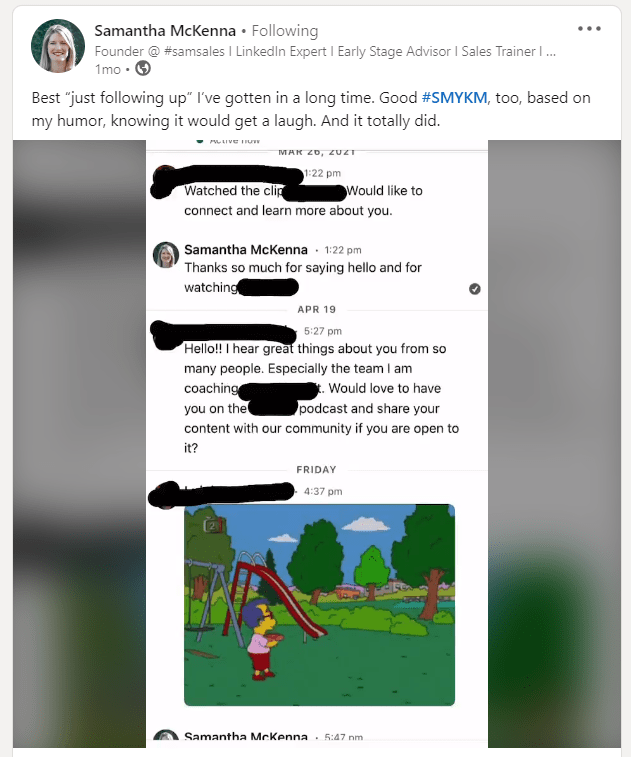You know the attributes of your ideal customer and list those who are more likely interested in your product or have a burning problem you can help. Next, you start an outreach program, prove your assumptions and qualify them for the next sales stage.
Around 32% of voters have 100+ unread emails in their inboxes. So your outreach should always stand out. That is why best practices continuously evolve, and such materials as this are always to the point.

The article is intended to help you design a working outreach strategy plan from scratch or refresh your current strategy. As with any tips and recommendations, we advise gradually implementing new tactics for your team. Otherwise, it will be challenging to bring them to a good performance level, and you’ll blame us that we provide bad tips :)
What is outreach in sales?
Sales outreach is reaching out to potential clients to generate warm and hot leads. Outreach is a part of prospecting, which includes making lists of relevant leads and contacting them to qualify further.
What is an outreach strategy?
An outreach strategy definition is a planned course of action to attract new high-priority customers faster. You should be purposeful about your sales outreach to control your result and get responses to your emails, calls, and social media messages.
How to do outreach for sales?
Step 1. Take your lead list
Step 2. Plan possible outcomes and your messages
Step 3. Start customer outreach in one or several channels
Step 4. Follow up at least 6 times
Step 5. Refine communication approach based on their reaction
With the plugin, you find and save prospects and their real emails on the go
Try itHow to outreach effectively?
-
Determine your best types of outreach
-
Warm-up leads before the initial message
-
Try your best in your first message
-
Refine sales outreach based on the buyer journey stage
-
Personalization: go for relevance
-
Quality vs. quantity in your sales outreach strategy
-
Try to stand out: catch their attention
-
Use media in your outreach campaigns (in case applicable)
-
Be on time with your replies
-
Follow-up: be strategic at getting a reply
-
Know when to stop your client outreach efforts
-
Automation: leave repetitive tasks to relevant tools
-
Sound personal while automating
-
Regularly testing smth new
-
Document and analyze customer outreach strategies
Types of outreach: determine the best for your business
Well-known channels are email, phone call, and social media. You probably also saw advice to try unusual channels with less competition, such as mail, FaceTime, Twitter, Skype, fax, etc.
Type 1. Email outreach
Type 2. Phone call outreach
Type 3. Social media outreach
Email outreach
Email is the most universal way of contact. It is easier to set up a system and quality standards across the sales team. As a sole contributor, you have time to craft and deliver a better message. Also, emails are less pushy than calls.
Phone call outreach
With calls, you get faster feedback => faster qualification => and faster move to the next prospects. At the same time, many people just ignore all unknown phone numbers and skip voicemails. It is difficult to control the quality of calls — a lot of spontaneity.
Social media outreach
It includes sending direct messages via social platforms, as well as connecting, offering valuable content, engaging with their posts. The type of outreach works better with prospects who are active online. For example, marketers, coaches, and salespeople.
You shouldn’t choose the channels blindly or because it is your typical way of reaching your clients. Among B2B types of outreach programs, LinkedIn is the most popular, though Instagram might be a better option if your customers are wedding photographers.
Base your choice on:
-
Buyer research. What do people with specific attributes prefer for communication? Consider their age, seniority, job title, industry, etc.
-
Regular A/B tests with groups of prospects.
Turn to those channels that give you the best response rate. We also recommend using a multi-channel sales outreach strategy when possible, so you can learn what channels work for the particular prospect.
Tip: monitor which combinations of channels are more effective and deliver more high-priority leads.
Warm-up leads before the initial message
To enhance the chances of getting positive replies, add warming up in your outreach before the first contact. The activity implies outreach marketing engagement with a prospect before any talks about their problems and your solutions. Here are some ideas to test:
1. Participate in online events they take part in as a speaker or just attendee. Ask questions and add valuable comments
2. Send them a postcard, a coffee, gift, or lunch
3. Like, repost, leave meaningful comments on their social media post
Valuable comment vs. useless, for the sake of commenting


4. Support initiatives they highlight as important, such as donating to the nonprofit they champion
5. Acknowledge their experience with profession/industry-specific comments in your outreach campaign, showing you know their staff. «Amazed by your project in the company!»
6. Recommend them or their company to others
7. Participate in discussions they are involved in communities on Facebook, Slack, and other forums
Try your best in your first customer outreach message
Initial cold email is your first impression and the beginning of the narrative you tell to a potential customer. Check these outreach methods to make the winning cold message:
-
Avoid being vague. Put numbers and benefits into your message instead of adjectives. Make sure you keep things clear and show significant differences from competitors.
-
Provide your message with a social acknowledgment of you and your company. It includes video reviews, a big brand among your clients, awards, referral, a considerable number of clients in their industry.
-
Clear call-to-action. It should be intuitive what the recipient needs to do after your email outreach. Also, make it easy to respond — use multiple-choice questions and avoid open questions.
-
Improve readability. Shorten your message to the main sentences by around 50 words and space out the text.
Refine sales outreach based on the buyer journey stage
Communication with cold leads, MQLs, SQLs, and opportunities differs. To lead your prospects to the purchase, know what to tell at what stage.

Cold leads. Your goal is to generate demand for your product. You chat about their problems, ask questions about their challenges, and share e-books and guides.
MQLs. You do pretty much the same, though they probably know something about your company and products, and your outreach can be more active.
SQLs. Here you justify why your product is the best solution for their challenge. You provide special offers for their company in your business outreach, share reviews, videos, product how-to guides, etc.
Opportunities. At this stage, it is crucial to keep their desire to buy till the sale. If possible, offer them a test period and softly follow up with tips and assistance.
Personalization: go for relevance
In most cases, you don’t need to perform deep research to know your prospect son's hobbies. Moreover, it is less important than pointing out relevance to their business in your customer outreach.
Finding information from their social media and website is easy. At the same time, good personalization starts when you logically tie discovered facts to your solution.
Avoid personalization for the sake of personalization. Better do less personalized message than pounding a square peg into a round hole. The samples below still work pretty good for SMB audience sales outreach, while you can easily automate this personalization.
Basic personalization samples
-
You work with their competitors
-
Mention their tech stack
-
They are hiring someone
-
A company raised funds recently
-
New executives
Tip: If you badly need a highly personalized message for your business outreach and find little to zero information about the company and buyer, you can start with small values. For example, you can talk about market change influencing their business, mention what happens to their main competitor, or send the report you’ve recently read about their niche.
Quality vs. quantity in your sales outreach strategy
There are many talks that you should always prioritize quality over quantity. By quality, we mean dedicating a lot of time to prospects' research and personalizing your messages. If you work in this mode, you end up with few reached prospects, which isn’t always a good outreach strategy example.
Recommendations for a successful sales outreach strategy
Tip 1. Quality over quantity works for enterprise sales.
Tip 2. Balance quality and quantity with small and medium deals.
Tip 3. Choose quantity over quality in the following cases:
-
you or your team are experienced. The more you practice, the less time personalization takes. When you are starting your career, it may take hours, and in years it may narrow to 20 minutes.
-
you tested many outreach SaaS approaches and chose and sharpened a working one. So you can scale it to make repeatable quality.
-
your company lacks a solid inbound effort. So you need to compensate for it by quantity to make your quality visible.
-
the audience of your product is very narrow. By adding specific industry success cases, your outreach campaign will look attractive with no need for deep research of each prospect.
Try to stand out: catch their attention
You should consider how to stand out to catch a prospect’s eye in the dozens of messages they receive and stir up opens.
Revise popular client outreach templates and don’t follow them.
Preparing emails dedicate part of the time to brainstorming an unusual subject line and first lines of text. The whole message might be templated, though not the beginning.
At the same time, the subject line should still point out what the message is about.
Try to be original in words in your effective outreach strategies — most languages are rich in synonyms. Also, experiment with approaches. For example, try omitting the subject line, refer to the person they know, and offer a new perspective on common practices in their work.
Use media in your outreach campaigns (in case applicable)
Visualized content is easier to digest, and audios might be more convenient to check on the go. At the same time, it doesn’t work for every audience. Especially when a more formal approach is required.
If you are hesitating — try adding media at 6-7 follow-ups when you have nothing to lose. We also recommend first trying them on social media customer outreach. Sending media via email have deliverability risks. Companies don't always cover them.
Here are some recommendations:
-
Videos and audios should be short and contain helpful tips rather than a pitch.
-
Don’t use memes for the sake of adding anything to your text. Choose or create those that make prospects think, «This is exactly about me!» or at least smile at your self-irony.

Check the GIF here.
-
Leverage images to convey your business outreach ideas better: schemes, diagrams.
Be on time with your replies
After the prospect finally replies to you, you should be here to respond back as soon as possible. Whenever you take too long to respond to a client message, your competitors are more likely to steal your ready-to-buy prospects.
As we aren’t bio-robots yet and can’t make many things simultaneously, below are some methods to deal with it.
How to use outreach
- 1 method. Send a short message about some delay and specify the deadline for reply. You have other things to do, and everyone understands. Just don’t leave them in uncertainty.
- Hi {name}. I got your message. I will reply in 3 hours. Sorry, I'm at the meeting right now.
- 2 method. Prepare answers to the most typical questions in advance for your customer outreach. Adopt to the prospect if necessary.
- Hi {name}. For more information, click here {link}. In an hour, I will be able to discuss the details. I am on my way to work right now.
- 3 method. Set up a mailing tool so that if you don’t answer in 10 minutes, it automatically sends a templated email.
- 4 method. Turn on notifications ;)
Follow-up: be strategic at getting a reply
There are plenty of reasons why the recipient skips your message despite the fact you use effective outreach methods. They lose it in a bunch of others in their inbox, put it off and forget, or always ignore all cold emails, etc. In most cases, while ignoring your contact attempts, they may be interested in your offering.
The key in your follow-up strategy is that you don’t deliver the exact same info through the exact same channel. With each next follow-up, you should amplify your first message by including helpful content.
Know when to stop your client outreach efforts
There is a moment when you should quit your outreach endeavors and shift your attention to new prospects. Here are some of the cases:
-
They ignored all your 7 messages.
-
They have zero budget for now.
-
They proceed with a competitor.
-
It isn’t a top priority now.
-
They are strictly refused and asked to be unsubscribed from your outreach campaign.
Tip: nothing stops you from contacting them again as cold leads in 3-6 months or after the executive change.
Automation: leave repetitive tasks to relevant tools
According to LinkedIn’s «Global State of Sales 2022», sellers only spend about 30% of their workdays actually selling. It is a feasible reason to optimize your sales outreach strategy continuously, isn’t it?
The following can be a good place to start:
-
Revisable templates, where you personalize the beginning and the end.
-
Sequences — prescheduled messages and actions based on the recipient’s reaction.
-
Scheduling emails, messages, and calls.
-
Scraping prospect information faster (such as find email address by name)
-
Pipeline analytics tools give you a clear picture of outreach campaign results with little effort from your side.
-
Customizable lead qualification tools.
Sound personal while automating
You may still sound human even if you send dozens and hundreds of emails. Sometimes it might work better than personalization. Check the tactics on how to change your template to feel more human.
Effective outreach methods with automation
-
Write the way you speak. It isn’t about turning to your local slang and obscene language. It's about not sounding too formal. So reread your template aloud to correct things you’d never say in a normal conversation.
-
Be honest. Mention prospects’ possible doubts associated with your company, industry, or profession. Even if you just talk through the situation, it gets much easier. This is a classic negotiating technique of «laying out the baggage». It has variations, though, in general terms, it's like this: if something affects a person's decision that everybody knows and nobody is talking about, then you should mention it.
-
Share your personal story. It is about a small abstract in your business outreach, e.g. describe your failure with prospects like them or your experience with a situation similar to theirs.
-
Speak about how you feel, such as being sleepy because of a newborn baby.
-
Start with a joke associated with the prospect niche, profession, or another common trait of the segment you are sending to. It is through laughter that two people become closer.
-
Demonstrate genuine curiosity in customer outreach. Ask a question about their profession or interests that you don't understand, and show that you have already done some research to find out the answer.
Regularly test smth new
It is a must-have when you are building the outreach process. Though when everything works well, experiments should also be an essential part of your routine. Your company, product, market, and customers are evolving, so your processes should.
Try new script, content, channels, combinations of channels, formats and tones, sending days and times. It may turn out that you are limiting yourself and can get even more replies and meetings from your outreach methods.
Important: ensure your sample size is big enough for your test to get meaningful results.
Document and analyze customer outreach strategies
Fix all your touchpoints with a prospect in CRM and confront them with the analytical tool's campaign numbers. Having this information, you can continuously polish up your outreach strategy. You will know what to remove and where to direct more efforts.
Summary
-
Regularly check trends on how to outreach to be on top of the competition
-
With an outreach strategy, you can anticipate more predictable positive results in opens, responses, meetings, and conversions
-
Base your outreach channel pick on research and testing
-
Dedicate special attention to the beginning of your message. It gives you opens
-
Set your processes this way, so you respond back as soon as possible
-
Follow-up in most cases. While ignoring your contact attempts, prospects may be interested in your offering
-
Value your time and stop your client outreach efforts when it doesn’t make sense to continue
-
Always think about how to optimize and automate your outreach
-
Experiments with outreach should be an essential part of your routine at any stage of your company
Google sheets add-on to get contact right in your rows
Try it

